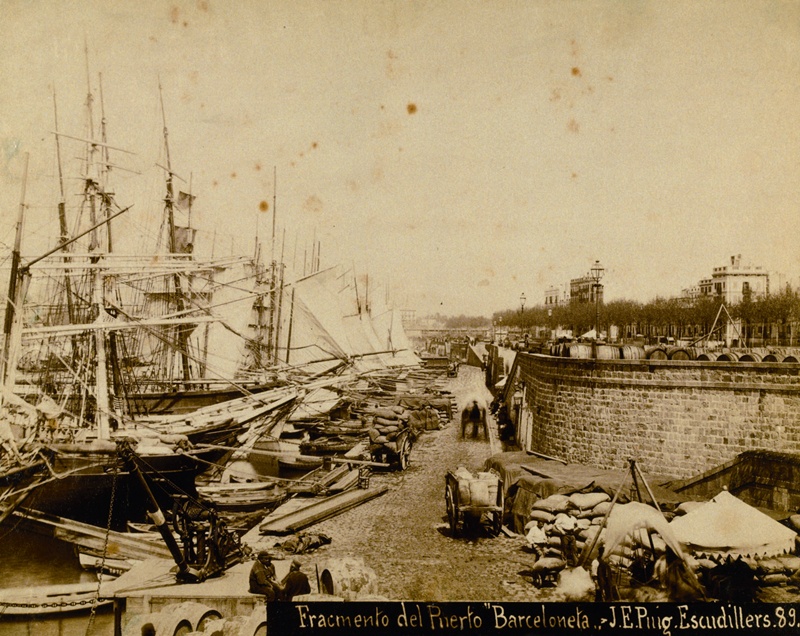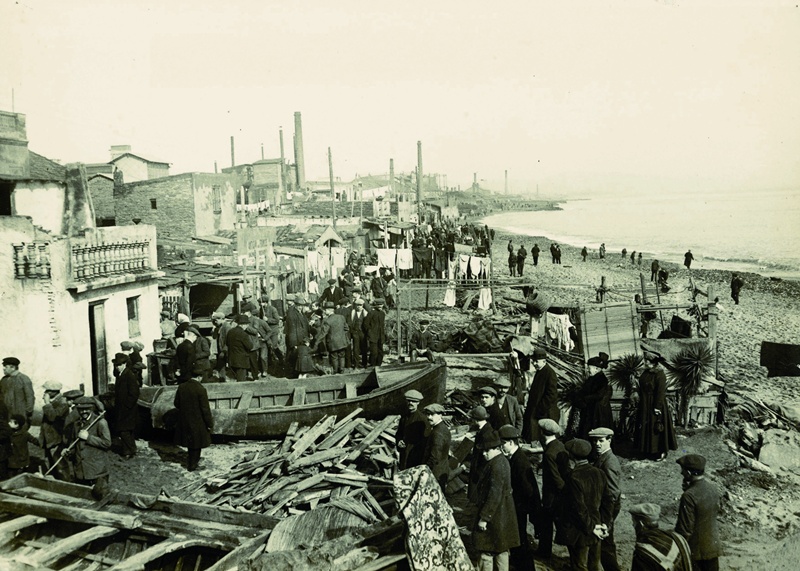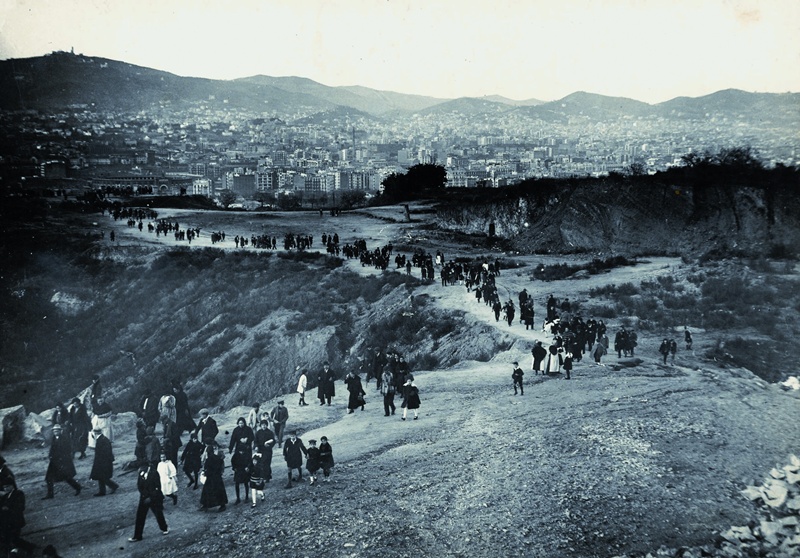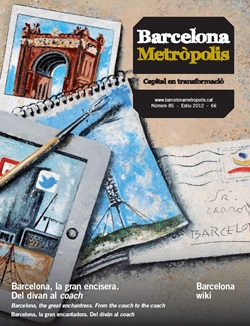I don’t know whether to put it down to age or headaches, but I tend to leave little bits of myself strewn all over the place, as though fearful of getting lost, or distrustful of those who govern me. Wont to look back at my childhood, I have to leave a trail of beans behind me. To see me properly you have to look up, seek me out behind a stone bench or peep into some hole. I am clumsy with details, wary and reserved. I stow my treasures with the avarice of one who is always on their guard. It is no coincidence that the archaeologists find mainly cannon balls of all sizes and from all eras. So many explosions and bombs have numbed my memory. I have allowed myself to be dazzled by ambitious projects all too often. I have not been a big planner; I have grown hastily and on the spur of each moment; I tend to change the decor of the house out of the blue. When I stop, I fall into a stupor, lulled into a kind of post-Sunday dinner spleen; that oh-so Catalan penchant for indifference which we call “seny” (good sense) here.
I was such a mere slip of a lass that I was barely visible behind my walls, which subsequently lay hidden for centuries between party walls. I sold the water to the ships that sailed from Empúries to Tarraco (now Tarragona). Now I can show off a chunk of a false aqueduct just in front of the Cathedral; for the tourists, of course. Afterwards I jumped over the walls and a whole bunch of new villages sprang up like an outbreak of adolescent pimples: the churches of Pi, Mar and Sant Pere, bequeathing numerous gothic facades and stonemason’s marks. The gate of the Orchard of the Templars is still with me, as is the hole of a Jewish mezuzah in a doorway in the Call Jewish Quarter.
Making the most of the sea traffic, I availed myself of new walls to contain the emerging neighbourhoods. And while I was at it, in the conviction that I was erecting houses for emigrants-to-come who would bring me good fortune, I also encircled the vegetable gardens of the Raval neighbourhood. Unfortunately, the Black Death came, and instead of growing I lost almost a third of what I was. Few memories remain of that nightmare, only my most beautiful churches: Santa Maria del Pi, Santa Maria del Mar and the cathedral. Those epidemics dragged on for more than a century, after which the soldiers arrived like a plague of locusts. The reapers revolted, and many of my stone corners still bear the marks of bayonets being sharpened. I was just about to make do with my size when they lopped a piece off me, just after the War of the Spanish Succession, to build the Ciutadella fortress. Half of my Ribera district was amputated; I still bear the scar of a house rent asunder in the passeig del Born. My skin is darned with symbols of the masonry, tattooed with old hurrahs with bull’s blood for ink, on the portals of the old university doctorates.
Years of dumping debris spawned a peninsula in front of the old island of Maians, which was baptised Barceloneta, home to seafaring folk and taverns, and where the old lighthouse still stands. Once shot of the walls I began to grow outwards, in all directions. The military granted me permission to populate Vinyars, a large security area which sheltered their cannons, and I called it the Eixample. Then I had a growth spurt. All of a sudden I grew up. I swiftly moved in from the plains, gobbling up all the municipalities in my path. The small villages encircling me never forgave me for that, and to this day they still look and feel independent. If you peer carefully into the folds of my dress you will find the main bars or centres that once stood in each little hamlet, where a village-like smell lingers on.

© Josep Esplugues / AFB
Alongside, a picture of the fishermen’s quay in Barceloneta taken between 1880 and 1889.
Later on I split the orchards of Sant Bertran into plots, whence Poble-sec, Paral·lel and the 1929 Expo eventually sprouted. You should have seen what a simple field of beans threw up! My playful nostalgia engendered my first shanty town in Montjuïc, surrounded by hen coops and tomato plants. Yet another civil war bequeathed me numerous little squares and avenues; the Italian air force city planners blasted an empty row where houses once stood in the Arc de Sant Agustí as a memento. Many years would pass before the square of the Unknown Militiaman was found, by chance, marked by a tar sign in Plaça de Sant Josep Oriol. No matter how hard the dictator tried to chastise me, rendering me bereft of new buildings in the centre, he unwittingly helped to save many of my old nooks and crannies from speculation. In the course of that protracted post-war period I welcomed some half a million new residents, even though I was unprepared to do so. The shanty towns Somorrostro, Pekín, el Carmel and la Perona; sites in my geography that were quickly demolished to avoid embarrassing the regime in the eyes of the world. With shockingly poor improvisation, the right to profit prevailed, as always, and I emerged laden with blocks of concrete, devoid of the basic services. The districts of Guineueta, Canyelles and Verdum shacked up with the adjacent municipalities, also chock-a-block with immigrants from the south. I thus became the centre of a metropolitan area with four and a half million inhabitants.
The last pieces of land conquered in my municipality paved the way to the sea and the Olympic Village. Others were cover-ups, such as the Fòrum, which conceals the much-feared Camp de la Bota execution ground. And some were conceived as a technological district, such as 22@.

© Alexandre Merletti / AFB
Underneath, the Pekín shanty town, located between Poblenou and Sant Adrià, hit by a storm in February 1919.
I continue to grow in fits and starts, resisting the temptation to surrender my personality and become a neutral and international place. I feel the melancholy of one waiting for a happening that will give me an excuse to turn things upside down. Meanwhile, my centre has become a monumental shop window.
I have always known that cities are more than just planning and statistics. We are all made of fragments of times past. I have a long and dense history to be proud of. I have managed to conserve a heap of places where the passions and longings that have shaped my life can be perused. Elsewhere in the world my walls would be adorned with metal plaques marking somebody’s birthplace or extolling some kind of event. On the other hand, I have always been a bit lazy about remembering some things. And I have often ended up having to do so due to local lobbying. There are whole parts of my biography which it pains me to show, while I often tend to pay too much attention to others. Opening the Civil War shelters was not easy for me, and I cannot stop thinking about what I am doing with the old theatres on Paral·lel. I barely talk about the libertarian period, as I do not I like to admit I was once a North American port. I seem to have just found out about the shanty towns, and we shall see what I eventually do with Montjuïc castle. Thank God I am by nature absent-minded and drop things along the way. Bird tracks on the sand that have to be sought out in private.
Despite my efforts, I talk very little to young people. Much of what I am lies outside the tourist circuits; my main clients should be the actual citizens of Barcelona. I harbour some hope of an increase in the range of guided tours, not just for schools, but also as a leisure activity. My documentary and photographic archives, many of them digitised and networked, should be publicised. I would like to see the Diari de Barcelona, one of the oldest daily newspapers in Europe, on the Internet. Local research groups must be fostered and their research disseminated. Initiatives such as the CERHISEC in Poble-sec, the Gràcia History Workshop, the Ignasi Iglésias Study Centre are good examples of this. Absent-mindedness has made me secretive, but not because I want only the initiated to read the messages on my walls.
Barcelona has been so successful in selling its image to the rest of the world that this has become its main source of income. The pressure of tourism in Ciutat Vella has driven out many inhabitants towards a series of metastases outlying the centre. There is a tangible and nostalgia-tinged reactivation of life in the neighbourhoods.

© AFB
At the foot of the page, people out strolling on the mountain of Montjuïc between 1910 and 1920, before the major reform of the International Exhibition.
In recent years, the maintenance of centennial public establishments, shops and businesses has been below par. At the same time, fancy private elements such as decorations on facades, public clocks and ornamental streetlights have vanished from the cityscape in the wake of the refurbishing of the buildings that once harboured them. The city is full of signs of old businesses waiting to be catalogued. The same can be said about the appearance of Civil War street lettering, and of sewer covers still in use that still bear the coats of arms of when the districts were independent municipalities.
History is everywhere, and the task of conserving it and publicising it must involve both the public organisations and amateur historians, who often make important findings. The most obvious case is that of Valerie Powles (1950 to 2011), the resident of Poble-sec who fought for the survival of air-raid shelter 307 and El Molino. As occurred with the first democratic city councils with the civic centres, nowadays the danger of depersonalisation could be staved off by leveraging local history, promoting a perception that sees the past as a recreational possibility, a sign of identity and an added value of living somewhere in Barcelona.




